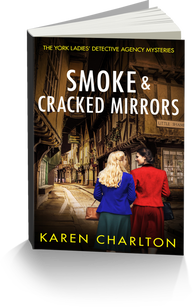Policing York in WW2
But what was behind this huge jump in crime on the home front? Especially in such a quiet, beautiful city, with its soaring 12th century Minster and quaint cobbled streets encircled by medieval walls. Unfortunately, the war brought with it a raft of new restrictions and regulations which many people chose to break or circumvent. Rationing of various staples of life offered huge opportunities to fraudsters, forgers and thieves and created a vibrant black market. Meanwhile the blackout allowed all sorts of criminal activities to flourish in the dark and chaos.
Another factor involved in the rapid rise in crime was the arrival of thousands of service personnel to Strensall Barracks and the four airbases that circled the city on the flat land of the Vale of York. Drunkenness, brawling and alcohol-induced accidents dramatically increased. The police had to drag bodies out of the River Ouse and one poor soldier even managed to kill himself by toppling from the top floor window of a hotel onto the cobbled paving of the street below. The indignant locals watched with horror as drunken brawls broke out in the hallowed precincts of the mighty York Minster and the tiny Minster Police Force (yes, York Minster has had its own police force since 1285) had a tough time stopping the vandalism.
Drunkeness amongst the young women of city also rose at an alarming rate as they flocked to the side of the soldiers and airmen in the dancehalls and the bars. Particularly popular with the girls were the Canadian air force men, who were paid four times as much as our British boys and were very generous with their cash. Alarmed at the number of intoxicated young women being hauled off to the police cells, the female leader of York’s Watch Committee asked the police to reconsider their earlier decision and start appointing female officers whom she felt should deal with the drunken girls. The request was promptly denied, and the ensuing argument spilled over into the pages of the Yorkshire Post.
The strong anti-German feeling prevalent at the time also caused the police headaches. Hundreds of German and Austrian Jewish refugees had been evacuated to the area and they, and many foreign business owners were subject to intimidation and attack. Even Chief Constable Herman didn’t escape suspicion. Despite his own exemplary WW1 service to his country, whispers began to circulate about his loyalty because of his surname. This led to hate-mail and direct calls for the resignation of Herman-the-German. He was robustly supported by the indignant Yorkshire Post.
The police spent far too much time and money recovering stolen cars and bicycles. R.A.F. Elvington, where two thousand men were stationed, was a particular problem. Every morning there’d be dozens of abandoned bicycles dumped in the ditch by the main gate. The weary police came in a van every day to retrieve them before attempting to return them to their owners. In fact, they were probably grateful when four German seamen escaped from the prisoner-of-war camp on York Racecourse, and they had to do some proper detective work for a change and track them down. (Which they did).
Despite the fact, that York was well-prepared for air raids with shelters and ARP volunteers and there were over eight hundred air raid warnings, no one really expected the city to be hit hard. York was internationally famous for its chocolate manufacture. Kit Kats and cocoa were hardly a threat to the Germans.
Yes, they’d converted part of the Rowntrees’ factory to make fuses for land mines and Terry’s chocolate factory was secretly manufacturing propellor blades for submarines, but most of the authorities expected the biggest attacks to be centred on the Hull Docks, thirty-eight miles away. York police were involved in several night-time practice manoeuvres, along with the ambulance service and others, which focussed on the dreadful potential scenario of escorting thousands of injured and traumatised refugees from Hull to the safety of the North Riding.
So secure were they in the notion that York wasn’t of much interest to the enemy, the children of York weren’t evacuated, and the city took in evacuated children from Middlesbrough and Hull.
All that changed on the night of 29th April 1942; the night of the infamous Baedecker Raid.
A month before, the R.A.F. had bombed the historic German city of Lübeck, causing a firestorm that burnt out dozens of ancient buildings and monuments. Hitler, enraged at the destruction, allegedly threw a copy of Baedecker’s Tourist Guidebook to British Cities at his Air Marshalls and instructed them to destroy every historic British building marked with three stars in the book.
In rapid succession, the Luftwaffe bombed Exeter, Bath and Norwich.
Unable to read the mind of this vengeful despot, British High Command were confused by this sudden change in strategy and failed to see the pattern. No warnings were issued.
And then, on the night of the 29th April, the Germans came for historic York.
There were no barrage balloons or anti-aircraft fire and the R.A.F were slow to scramble to the city’s defence. Unopposed, the German aircrew dive-bombed the streets strafing the terrified civilians with machine-gun fire as they tried to flee the falling masonry. The ancient Guildhall and several medieval churches were blazing, and the convent was hit killing five nuns. Blinded by dust, the terrified citizens of York scrambled on their hands and knees amongst the rubble and the shattered glass, trying to dig out the bodies of their injured and dead.
But the one thing the Germans failed to hit was the biggest bloody building for fifty miles: York Minster.
As dawn broke over this ancient Roman city, which had seen off centuries of plague, pestilence and invading Scots, York’s exhausted residents took comfort from the fact that somewhere, above their smoke-filled streets, the Minster’s honey-coloured, gothic towers were still soaring serenely into the sky in defiance.

SMOKE & CRACKED MIRRORS
by Karen Charlton
Available on Amazon in eBook and Paperback
£5.99/$5.99






 RSS Feed
RSS Feed